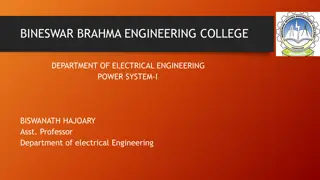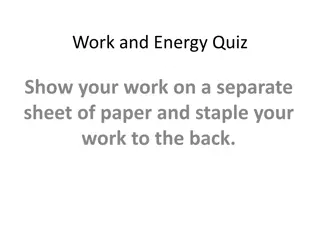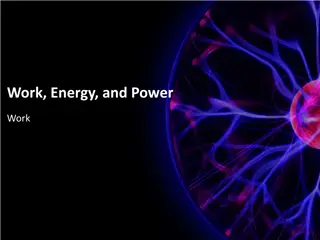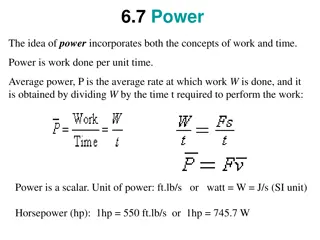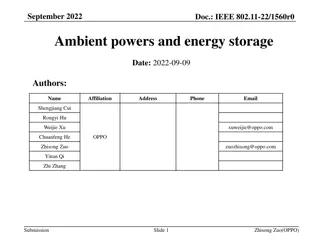Understanding Work, Energy, and Power in Physics
Work, energy, and power are fundamental concepts in physics. Work is done when a force acts on an object causing it to move, with specific conditions determining the work done. Mechanical energy examples include kinetic, elastic potential, and gravitational potential. The relationship between mass, height, and potential energy or velocity and kinetic energy are explored through examples. Additionally, the concept of work as defined by scientists is discussed, highlighting the distinction between everyday activities and scientific definitions.
Download Presentation

Please find below an Image/Link to download the presentation.
The content on the website is provided AS IS for your information and personal use only. It may not be sold, licensed, or shared on other websites without obtaining consent from the author. Download presentation by click this link. If you encounter any issues during the download, it is possible that the publisher has removed the file from their server.
E N D
Presentation Transcript
Work is done when 1. the displacement is not zero and a force is parallel to the displacement 2. the displacement is zero. 3. the force is zero. 4. the force and displacement are perpendicular. 0% 0% 0% 0% the displaceme... the displaceme... the force is z... the force and ...
Which of the following is an example of mechanical energy? 1. Kinetic 2. Elastic Potential 3. Gravitational Potential 4. All of the above 0% 0% 0% 0% Kinetic All of the abo... Gravitational ... Elastic Potent...
A 75kg man and a 55kg woman perform dives on adjacent diving boards of the same height. Which of them will have a greater kinetic energy entering the water? 1. The man 2. The woman 3. Both will be the same 4. Unable to be determined 0% 0% 0% 0% The man The woman Both will be the same Unable to be determined
A 75kg man and a 55kg woman perform dives on adjacent diving boards of the same height. Which of them will have a greater speed entering the water? 1. The man 2. The woman 3. Both will be the same 4. Unable to be determined 0% 0% 0% 0% The man The woman Both will be the same Unable to be determined
If both the mass and the height of a ball are doubled, the potential energy of the ball is increased by a factor of 1. 2 2. 3. 4 4. 8 5. 16 0% 0% 0% 0% 0% 2 4 8 16
If both the mass and the velocity of a ball are tripled, the kinetic energy of the ball is increased by a factor of 1. 3. 2. 6. 3. 9. 4. 27. 0% 0% 0% 0% 3. 6. 9. 27.
Of the following examples, the one that represents work as defined by a scientist is: 1. lifting a book from your desk. leaning on a shovel while others labor. pushing hard against a wall for an hour. carrying a heavy box on your head. 2. 3. 4. 0% 0% 0% 0% pushing hard against a w... lifting a book from your... carrying a heavy box on... leaning on a shovel whil...
Which of the following represents the capacity to do work? 1. Power 2. Energy 3. Force 4. Acceleration 5. Velocity 0% 0% 0% 0% 0% Power Force Energy Velocity Acceleration
A machine that does more work than another must have moved the object is a shorter amount of time? 1. True 2. False 0% 0% True False
Which of the following represents the rate that work is being done? 1. Power 2. Kinetic Energy 3. Potential Energy 4. Total Energy 0% 0% 0% 0% Power Total Energy Kinetic Energy Potential Energy
A mouse and a raccoon race to the top of a tree for the last morsel of food left before winter. Both arrive at the top at the same time. Which had more power? 1. Mouse 2. Raccoon 3. Same 4. Unable to be determined 0% 0% 0% 0% Same Mouse Raccoon Unable to be d...
A linebacker pushes against the blocker but the blocker does not move. The work is: 1. Positive 2. Negative 3. Zero 4. Not enough info 0% 0% 0% 0% Zero Negative Positive Not enough info
When doing a bench press, you gradually raise the bar. The work done by gravity is: 1. Positive 2. Negative 3. Zero 4. Not enough info 0% 0% 0% 0% Zero Negative Positive Not enough info
When doing a bench press, you gradually lower the bar down to your chest. The work done by your arms is: 1. Positive 2. Negative 3. Zero 4. Not enough info 0% 0% 0% 0% Zero Negative Positive Not enough info
Because your two-year old cousin refuses to move, you pull him along the ground. The work done by friction is: 1. Positive 2. Negative 3. Zero 4. Not enough info 0% 0% 0% 0% Zero Negative Positive Not enough info
A rolling wagon has 50 joules of kinetic energy. If the wagon s velocity is doubled, the kinetic energy of the wagon: 1. is reduced to 25 joules. 2. is increased to 100 joules. 3. is increased to 200 joules. 4. remains the same. 0% 0% 0% 0% remains the same. is reduced to 25 joules. is increased to 100 joules. is increased to 200 joules.
In a closed system, what is constant? 1. Potential energy 2. Kinetic energy 3. Mechanical energy 4. All are constant 0% 0% 0% 0% Kinetic energy Potential ener... Mechanical ene... All are consta...
Two rescue packages of equal mass are dropped from planes of different altitude - red plane at 1500m and a blue plane at 2500m. Which of them will have a greater speed hitting land? 1. Red plane s package 2. Blue plane s package 3. Both will be the same 4. Unable to be determined 0% 0% 0% 0% Both will be the same Red plane s package Blue plane s package Unable to be determined













